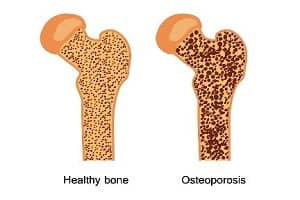What is osteoporosis?
Osteoporosis is a condition of bone that is characterized by a decrease in the density and strength of the bone resulting in fragile bones. This condition occurs when:
- the body loses too much bone
- makes too little bone
- or both simultaneously

Osteoporosis literally means porous bone (a bone that is compressible, like a sponge). This disorder weakens the skeleton and results in frequent bone fractures.
Osteoporosis and bone density
The body maintains bone density and its structure in a certain way. The bone tissue is renewed regularly. New bone replaces the old and damaged bone and maintains the integrity of the bone tissue.
Bone density is at its peak when a person is in his late 20s. Bone starts to become weak after the age of 35. With age, bone breaks down faster than it builds. This disturbs the balance of the bone tissue resulting in abnormal conditions like osteoporosis.
Bone is made up of three major components that make them flexible and strong:
- Collagen – a protein that gives bones a flexible framework
- Calcium-phosphate complexes – these are minerals-based complexes that help make our bones hard and strong
- Living bone cells – used to remove and replace sections of bones that become weak over time
Healthy bones vs porous bones: How do bones with osteoporosis look like?
When viewed under a microscope, a healthy bone looks like a honeycomb. If you have osteoporosis, the holes and spaces in the honeycomb increase in size and number. Osteoporotic bones have less density or mass than a healthy bone without osteoporosis.
Risks with bones if you have osteoporosis
Less dense bones are weak and are more likely to break. The fracture in the bone can be in the form of:
- cracking (a hip fracture)
- collapsing ( fracture of the vertebrae of the spine)
Osteoporosis can cause fractures in almost any skeletal bone such as in the arm or pelvis but the most common injuries are:
- wrist fractures
- hip fractures
- fractures of the spinal bones (vertebrae)
- rib fracture (sometimes caused by a cough or sneeze)
Osteoporosis develops slowly over several years without showing any symptoms and is only diagnosed after a minor fall or sudden bone fracture. It is not usually painful until a fracture occurs, but spinal fractures cause a long-term (chronic) pain.
Some Facts About Osteoporosis
- Osteoporosis is a condition of fragile and weak bone which increases the risk of fracture
- Bone mass (bone density) decreases with age especially after 35 years of age
- Bone loss is more common in women especially after menopause
- Lack of calcium and vitamin D are the key factors for causing osteoporosis
- Patients with osteoporosis experience no early symptoms until first bone fracture
- The diagnosis of osteoporosis includes tests that measure bone density
- Osteoporosis can be treated and prevented by adopting certain measures and increasing the intake of calcium and vitamin D
Osteoporosis is Common
It is estimated that 50 percent of women and 25 percent of men break a bone due to osteoporosis in their lifetime. This condition becomes more common and even severe with age.
Osteoporosis is Serious
Osteoporosis is a serious problem and the most serious complication is a bone fracture. Older patients have severe complications than the younger ones.
Hip, spine and wrist are the common bones which are affected by the disease. And these are important bones of one’s body. Functioning with these bones being fractured is a tough task. Fracture is accompanied with permanent pain.
Osteoporosis can also cause some patients to lose height. It is because when osteoporosis affects vertebrae (the bones of the spine), it becomes difficult for the patient to support the weight of the body and develop a stooped or hunched posture.
Causes of Osteoporosis
The main cause of osteoporosis is lack of calcium and vitamin D in the body that makes the bone weak and brittle.
Other causes may include low estrogen in women, low testosterone in men, sedentary lifestyle and thyroid conditions. Read more about causes of osteoporosis.
Diagnosis of Osteoporosis
To diagnose the osteoporosis, the doctor suggests a bone density scan. It is done to determine the proportion of mineral in bone. It is done by a machine in a procedure called bone densitometry. This test is usually painless and it checks only a few bones such as hip, wrist and spine.
Read more about diagnosing osteoporosis.
Treatment of Osteoporosis
Treatment of osteoporosis includes the treatment of fractures and their prevention by strengthening the bones with medications.
Strontium ranelate, Bisphosphonates and selective estrogen receptor modulators (SERMs) are some of the medications used to treat the osteoporosis. Read more about treatment of osteoporosis.
Prevention of Osteoporosis
Osteoporosis can be prevented in the following ways:
- a diet rich in calcium and vitamin D
- exercise for bone strengthening
- medications that increase bone strength







